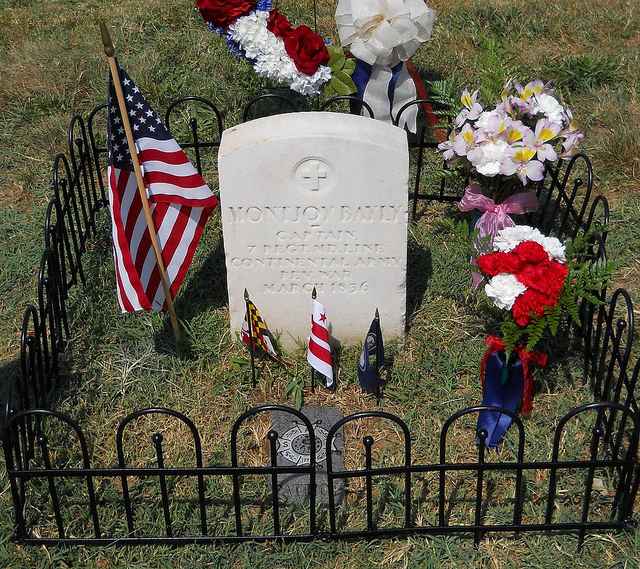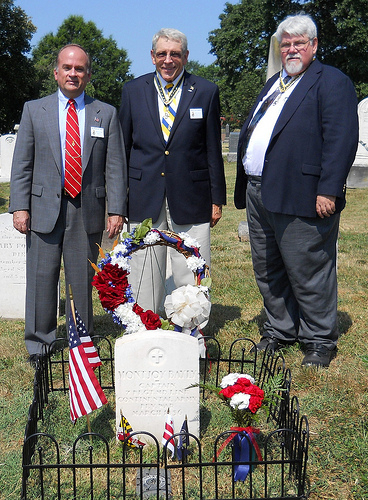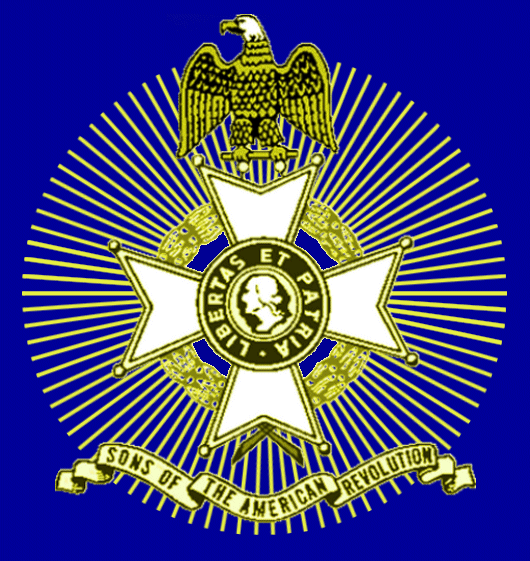Mountjoy Bayly in the Revolutionary War
Frederick County, Maryland
By William W. Price & John D. Sinks
Fairfax Resolves Chapter, Virginia Society & District of Columbia Society,
Sons of the American Revolution
July 4, 2012
Today we recognize Mountjoy Bayly (1755-1836) for his contributions to the cause of American Independence during the Revolutionary War. Mountjoy was born about 1755 in Fairfax County, Virginia to William and Mary Hampton Bayly.1 As a young man, he appears to have preferred the spelling “Bailey,” but “Bayly” in his later years. He first appears in the Shelburne Parish, Loudoun County, Virginia Tithable records in 1774 as the overseer for his older brother, Samuel Bayly of Colchester.2

Mountjoy Bayly Grave Marker
Click to Enlarge
When Maryland took its census in 1776, Mountjoy Bayly, age 21, was listed in the Lower Potomac Hundred of Frederick County with no other members of his household.3 His older brother Edward, age 23, was listed on the same page. Frederick County at the time included what is now Montgomery County and all Maryland counties to the west. Today we would recognize the Lower Potomac Hundred as the Bethesda-Chevy Chase area. It was here in the year 1776 that Mountjoy Bayly began his Revolutionary service.
About April of 1776 Col. John Murdock appointed Mountjoy Bayly as Adjutant of the 29th Battalion, Frederick County Militia.4 By June Bayly’s service in the 29th was nearing an end without the unit having been engaged in a campaign. George Washington had devised the idea of recruiting militia from the middle states to provide a mobile force to threaten the British. The Maryland Convention resolved on June 25th to provide a 3,405 of its militia to act with the militia of Pennsylvania and Delaware according the request of the Continental Congress, received on June 3rd. The Maryland Flying Camp was to be organized in four Battalions. The western-most battalion was the 1st, from Frederick County and commanded by Col. Charles Greenbury Griffith. Montjoy Bailey was commissioned adjutant of the 1st Battalion on September 7, 1776, the same date as other staff officers of the 1st.5 By September 16th Griffith’s battalion was with the Main Army at Harlem Heights and some were engaged in the battle that day. The Maryland delegation in Philadelphia reported that Griffith’s men“behaved well.”6 One company of the 1st, Capt. Henry Hardman’s, was captured at Ft. Washington on November 16th when the patriots failed to abandon the fort in time.7 The battalion was also in the Battle of White Plains.8 With enlistments expiring at the end of the month, the battalion was marched to Philadelphia in December and discharged. One soldier testified that he promptly returned home, arriving a few days before Christmas.9
By December of 1776 additional Maryland regiments of the Continental Line were being established. The first commissions for the 7th Maryland Regiment were issued on December 10, 1776 and Mountjoy Bailey was among 9 officers commissioned that day.10 Not until March 27, 1777 was the regiment organized to consist of eight companies, and on May 22nd it was assigned to the 1st Maryland Brigade,11 Brigadier General Thomas Smallwood commanding.
The new responsibilities of Mountjoy Bayly did not wait until the regiment was organized and did not involve immediate combat service. They involved the imprisonment of captured Tories.12 In a letter from Major General Israel Putnam dated December 15, 1776, Captain Bayly is instructed to transport 16 Loyalist prisoners held in Frederick County to the public jail in Lancaster, Pennsylvania. Putnam’s use of the rank “captain” indicates that he was not addressing the order to an adjutant, Bayly’s rank in the Flying Camp.
The first major engagement for the 7th Maryland and Captain Mountjoy Bayly was on September 11, 1777 at the Battle of Brandywine. An interesting account of the maneuvers leading up to the battle survives in a letter by Dr. William Darlington dated November 29, 1845. The letter relates a narrative from an 1822 dinner with Mountjoy Bayly:
Captain Bayly said his company was detached as a scouting party on the day of the battle, to obtain information and watch the movements of the enemy. In traversing the hills on the west side of the forks of the Brandywine he came to a comfortable farmhouse…, the proprietor of which he soon learned was a namesake of his own and a zealous loyalist. The hospitable old farmer mistook the Maryland Company for British, and greeted them with a hearty welcome. He caused a generous lunch to be produced for them, of which they freely partook, and Mountjoy kept his aged host in pleasant conversation, without in any way correcting his misapprehension. Having got through with the entertainment, the advance of the British column was seen approaching, when Captain Bayly concluded it was about time for his Marylanders to be moving. He so stated to the hospitable old farmer, who thereupon urged him to remain, assuring him that the approaching troops were certainly good friends. Captain Bayly, however, excused himself by alleging that the duty of his company was to keep some distance ahead of the column, and so he speedily made his escape from a rather critical position.13
Mountjoy Bayly and the 7th Maryland arrived with the rest of the Continental Army at Valley Forge on December 19, 1777. The conditions were stark: the 400 or so soldiers of the 7th Maryland received 346 pairs of shoes, 308 stockings, 200 trousers, 183 jackets, and 172 shirts when clothing was finally issued on January 27, 1778. Yet Valley Forge also marked the arrival of von Steuben and the re-forging of the Continental Army into a victorious fighting force. Mountjoy Bayly and the 7th Maryland marched away from Valley Forge on June 19, 1778.

Fairfax Resolves members Bill Price and Jack Sweeney stand behind the Mountjoy Bayly grave marker with DC Society compatriot John Sinks.
Captain Bayly was injured during the Battle of Monmouth on June 28, 1778. In his application for a Revolutionary War pension14 he describes his injuries as “ruptured a blood vessel so as leaving me unfit for duty.” He was sent to the Continental Hospital at Bethlehem, Pennsylvania. We do not know how long Bayly was in the hospital, possibly until 14 September 1778 when he resigned his commission. When applying for a pension and bounty land, he claimed that his regiment marched south before he had recovered. However, the 7th was not assigned to the Southern Department until April 7, 1780, about a year and a half after his resignation.15 Bayly wanted back in service and there was soon an opportunity for Continental commissions in Maryland. The General Assembly passed a law to procure Recruits to complete the Battalions of this State in service of the United States and to raise an Additional Regt if necessary. The Council of the State of Maryland appointed officers who would recruit men and if an additional regiment was authorized, lead it. Mountjoy Bailey was appointed captain of the first company. With regiments throughout the Continental Army under strength in this time period, the recruits were welcomed but a new regiment was not needed.16 Bailey’s recruiting duties continued in 1781. In March he was appointed recruiting officer for Frederick County, with rank of captain, and authorized Washington County was ordered to send their recruits to him.17
After the victory at Yorktown, Bailey again found himself dealing with prisoners. The Council of Maryland expected at least 2,000 prisoners and ordered the Select Militia of Montgomery, Frederick, and Washington Counties out to guard them.18 Col. Philip Thomas, County Lieutenant of Frederick County, was ordered to appoint Capt. Mountjoy Bailey as commanding officer of the guard under him. Bailey soon resumed a continental position. Col. James Wood had responsibility for prisoners of war as early as 1778, when he was in command at Charlottesville where prisoners captured at Saratoga were then held. He later became commissary for the prisoners, and in December of 1781 was appointed Superintendant of Prisoners of War in Virginia. At some point Wood was authorized to call an officer into service with a rank between captain and colonel inclusive to assist him with the prisoners. Bayly filled this position and served at Frederick, Maryland, not Virginia.19 Pvt. Johann Conrad Döhla, a Hessian diarist who was captured at Yorktown and imprisoned at Frederick, Maryland, referred to Bayly as the “local city major and commandant of prisoners.”20 Döhla and another Hessian, Lt. Johann Ernst Prechtel, recorded between them that Bayle mustered the prisoners eleven times somewhat over a year at Frederick.21 Most of the time it would appear that the prisoners had few limitations on their movements, however, prisoners could be arrested and confined. Disrespect of guards was one offense. On June 18, 1783 a Hessian lieutenant got into a dispute during a card game and challenged a Continental officer to a duel. Bailey himself ordered the lieutenant arrested.22 The Hessian officers could also arrest prisoners. Colonel Seybothem ordered the arrest of two prisoners for marrying American women without permission. Desertion was a problem of concern to both sides. Pvt. Döhla wrote on August 12, 1782, “As of the first of August, all prisoners of war put in the jail by Major Baily, as well as Major von Beust, receive daily only two-thirds rations, so as to deter the many desertions into the country.”23 Bayly advanced money from his own pocket to support the prisoners. On December 27, 1781, he was reimbursed by the colony of Maryland £76.5 for prisoner expenses he paid from his own pocket. It was not unusual for officers to pay expenses out of their own pocket and seek reimbursement later, and they were not always successful in securing reimbursement.
Mountjoy Bayly’s service was not limited to that of a soldier. There are three records of Mountjoy Bailey providing supplies to the Commissary of Purchases: provisions on 21 May 1781, hay and corn on May 29, 1781, and also on May 29th beef and flour.24
Shortly before Evacuation Day officers of the Continental Army formed the Society of Cincinnati. Mountjoy Bailey joined the Maryland Society as an original member. After the Revolution he served as a member of the General Assembly representing Frederick County, Brigadier-General of the Maryland Militia, and the Sergeant-at-Arms for the United States Senate.25 He died on March 23, 1836.
This final resting place of Mountjoy Bayly, Citizen, Soldier, and Patriot, is proudly recognized today, on the two hundredth and thirty sixth anniversary of the Independence of the United States, by The National Society of the Sons of the American Revolution.
1 Papenfuse, pp. 119.
2 Loudoun Tithables, p. 731.
3 1776 Census, p. 63.
4 Arch. Md., Vol. 11, pp. 522-523; Arch. Md., Vol. 12, pp. 112-113.
5 Arch. Md., Vol. 12, pp. 179-180.
6 Fetzer, p. 28.
7 Arch. Md., Vol. 12, p. 473.
8 Heeter.
9 Heeter.
10 7th Md. Regt. Rolls, image 71.
11 Wright, p. 280.
12 Papers Cont. Congress, pp. 111, 115, 117.
13 Hist. Chester Co., p. 80.
14 Bailey.
15 Wright, p. 280.
16 Arch. Md., Vol. 43, pp. 233-234, 254.
17 Arch. Md., Vol. 45, pp. 356, 358, 367, 369.
18 Arch. Md., Vol. 45, pp. 658-660.
19 Bailey.
20 Döhla, p. 200.
21 Döhla. pp. 200, 205, 206; Prechtel, pp. 235, 236, 239-241, 244, 245, 247, 249, 250.
22 Hessian Barracks.
23 Döhla, p. 209.
24 Md. State Papers.
25 Papenfuse, p. 119.
![]()
Selected Bibliography
Archives of Maryland, Volume 11, Maryland Historical Society, Baltimore, 1892.
Archives of Maryland, Volume 12, Maryland Historical Society, Baltimore, 1893.
Archives of Maryland, Volume 42, Maryland Historical Society, Baltimore, 1924.
Carothers, Bettie Stirling (comp.): 1776 Census of Maryland, Lutherville, by the author.
Döhla, Johann Conrad (Bruce E. Burgoyne, translator and editor), A Hessian Diary of the American Revolution, University of Oklahoma Press, Norman, 1990.
The Hessian Barracks, Frederick, http://www.facebook.com/HessianBarracks1777
Fetzer, Marie Rasnick, “The Hessian Barracks of the Revolutionary War at Winchester, Virginia & Frederick, Maryland, from the German (Yorktown) Prisoner’s of War Perspective,” http://www.rasnickfamily.org/thehessianbarracks.pdf
Futhey, J. Smith and Gilbert Cope, History of Chester County, Pennsylvania, Vol. 1, Louis Everts & Co., Philadelphia, 1881.
Hiatt, Mary & Craig Roberts Scott: Loudoun County Virginia Tithables, 1768-1786, Vol. 2, pp. 733.
Maryland State Papers (Series A) 1780-1781 (MSA SSI 1004-31, #10393, 10482, & 10483), Maryland State Archives.
Papenfuse, Edward C., Aland F. Day, & David W. Jordan: A Biographical Dictionary of the Maryland Legislature, 1635-1789, Vol. 1, Johns Hopkins University, Baltimore, 1979.
Papers of the Continental Congress, Maryland and Delaware State Papers, M-247, Item 70, National Archives.
Pension File of Mountjoy Bayly (S-12094, BLWt 685-300), National Archives, Washington, DC.
Pension File of George Heeter (S-16410), National Archives, Washington, DC.
Prechtel, Johann Ernst (Bruce E. Burgoyne, translator and editor), A Hessian Officer’s Diary of the Amerian Revolution, Heritage Books, Inc., Westminster, Md, 1994.
Revolutionary War Rolls, 7th Maryland Regiment, 1777-1778, M-246, Roll 34, Folder 25.
Steuart, Rieman: A History of the Maryland Line in the Revolutionary War, 1775-1778, Society of Cincinnati of Maryland, 1969.
Wright, Robert K., Jr.: The Continental Army, Center for Military History, United States Army, Washington, DC, 1983.

